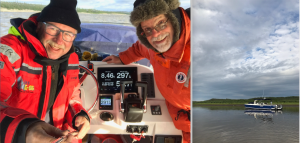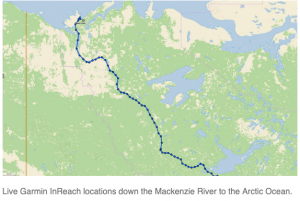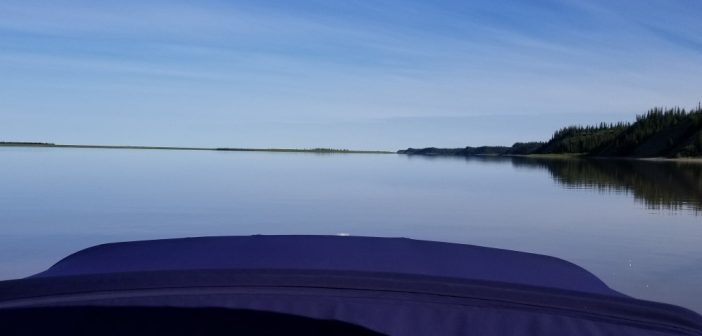
You don’t need to ask Larry Graf what he did on his summer vacation this year. Graf, the president and “chief adventurer” of Aspen Power Catamarans, and Peter Robson, a Canadian journalist, drove a new 34-foot, twin outboard Aspen 1,092 miles down the Mackenzie River through Canada’s remote and wild Northwest Territories – where there are more bears than people – to the Arctic Ocean. The trip took six days and 22 hours.
The Mackenzie is the largest river in Canada, and the second largest in North America, after the Mississippi (see the map, below). There are no electronic charts for the river, which is one of the most complex river systems in the world. For the trip, Graf put together a series of 40-year-old paper charts that often were often woefully incorrect. There were buoys on parts of the river, but often they had been dragged and damaged by logs or washed up on shore. On long stretches, there were no aids to navigation at all.
On the last day, after leaving the little town of Inuvik, they wrote that there was “more crazy navigation,” with no buoys to mark the route, and they had to zig-zag at 3 to 5 mph trying to find deep water. “I can’t believe we didn’t crack up the boat, or us,” Robson wrote.
When they got to the Arctic, Graf tried to fly a drone to get aerial pictures but it caught a gust of wind and crashed into the ocean. Robson, meanwhile, dipped his toes in the frigid saltwater and then cracked open a celebratory Kokanee beer.
The trip started back at the Aspen factory in Burlington, Washington, where Graf put the new L107 on a trailer and towed it 1,171 miles over the Canadian Rockies to the mouth of the Mackenzie River, where they launched it. They cruised north, down the river, passing in the shadow of towering green mountains, wild forests, and 200-feet-high sandstone cliffs.
As they got closer to the Arctic, the topography changed dramatically. “Up here, the terrain is drastically different,” they wrote. “Zero trees. Low bushes, maybe four-feet tall – but a very deep green.” And not many people.
The day that Graf and Robson crossed into the Arctic Circle (see the picture showing the latitude on their chart plotter, above; Graf is at right), they said at one point they cruised for five hours at 24 mph and did not see a single person or a single manmade object. They did see sandbars and islands that were not on the paper chart, and at times they had to come to a full stop and reverse out to find the channel.
Half-way through the trip they had to navigate through rapids that were notorious for destroying boats, but the Aspen, with the company’s patented asymmetrical hulls (the port hull is 35 percent smaller than the starboard one), made it through unscathed. The boat has a 200-hp Yamaha on the starboard hull, and a 70-hp Yamaha on the port side.
The boat carried 190 gallons of fuel, which gave them a range of 300 miles at 23 mph. And they were able to find enough indigenous villages with gasoline to keep them going, although at several points they ended up carrying jerry cans of gas back and forth to the boat.
They didn’t have to worry about running at night. By the end of the trip they were so far north that the sun didn’t set. The L107 is basically an open boat, but the wraparound seating in the bow converts into a sleeping area protected by a dodger. A large Bimini over the helm provided protection from the elements, and it had solar panels to provide power. For creature comforts, the Aspen had a fully enclosed day head, and an outdoor galley with a fold-down table and seating.
It had something that no other Aspen has ever needed: special rails across the transom to keep the bears away. They also carried “bear boards” with nails sticking out for the same purpose. As it happened, they saw lots of bears on shore, but none made it to the boat.
LOA: 36’8”; Beam: 10’0”; Draft (engines half tilt): 22”; Disp.: 7,200 lbs.; Fuel: 120 gals. plus 70 gals. expedition reserve; Water: 20 gals.; Power: 1×200-hp Yamaha; 1×70-hp Yamaha.

http://aspenpowercatamarans.com




